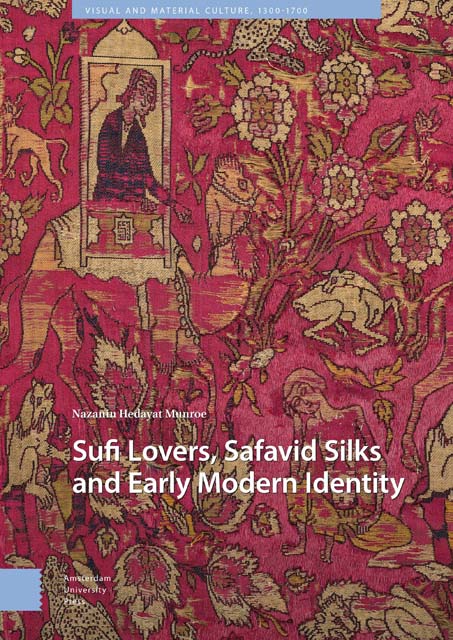Book contents
- Frontmatter
- Dedication
- Table of Contents
- Acknowledgments
- List of Illustrations
- Note on Transliteration
- Introduction: Material Culture and Mysticism in the Persianate World
- Part I
- Part II
- Conclusion
- Appendix A List of Khamsa Silks
- Appendix B Summary of ‘Shirin and Khusrau’ by Amir Khusrau Dihlavi
- Appendix C Summary of ‘Majnun and Layla’ by Amir Khusrau Dihlavi
- Glossary of Textile Terms
- Glossary of Persian and Arabic Terms
- List of Historic Figures
- Index
6 - Safavid Figural Silks in Diplomacy: Rare Textiles of Novel Design
Published online by Cambridge University Press: 19 April 2023
- Frontmatter
- Dedication
- Table of Contents
- Acknowledgments
- List of Illustrations
- Note on Transliteration
- Introduction: Material Culture and Mysticism in the Persianate World
- Part I
- Part II
- Conclusion
- Appendix A List of Khamsa Silks
- Appendix B Summary of ‘Shirin and Khusrau’ by Amir Khusrau Dihlavi
- Appendix C Summary of ‘Majnun and Layla’ by Amir Khusrau Dihlavi
- Glossary of Textile Terms
- Glossary of Persian and Arabic Terms
- List of Historic Figures
- Index
Summary
Abstract
Khamsa silks are considered within the larger genre of Safavid figural textiles. These finely woven silks were often brocaded with metal-wrapped threads in gold or silver. Depicting non-narrative scenes of figures reading poetry in gardens or hunting, these function as representations of kingship in Persianate culture as warrior and spiritual leader. Silks are a valuable commodity for Iran, gifted across Eurasia as exemplary samples to encourage trade of raw fibre, whose profits benefit the state. Figural silks in early modern diplomatic relations are analyzed through surviving garments and depictions, including ambassadorial khil‘at worn by Robert Sherley and Naqd ‘Ali Beg. Textiles gifted between Safavid Iran and Mughal India, and the display of figural silks as a representation of identity, are examined in detail.
Keywords: diplomatic gift giving, Robert Sherley, Teresia Sherley, Shah ‘Abbas I, Jahangir, Shah Jahan, Safavid velvet
Khamsa silks are part of a larger genre of figural textiles that were coveted luxury objects throughout Eurasia. In addition to being imbued with complex iconological properties for those familiar with Sufi poetry, silk textiles in the early modern Persianate world were a representation of the talent and wealth of the realm that produced them. Safavid figural silks were highly esteemed by monarchs throughout Europe and the Islamic world, and surviving examples demonstrate the value of these sumptuous textiles, which were stored in palace treasuries or used by the church to wrap reliquaries and fashion liturgical garments, such as the Majnun velvet chasuble (fig. 5.2). In addition to the new proposed provenance and dating discussed in Chapter 5, the use of this prized velvet to create a liturgical garment demonstrates that the production of silks depicting characters from the Khamsa evoked an appreciation for the fabric itself – even outside the Persianate world, where the poetry and characters may not have been recognized by viewers.
Silk was also an important commodity controlled by the Safavid state. In addition to selling woven products, Shah ‘Abbas I sought to corner the market in the lucrative sale of silk fibre, and figural textiles may have been presented as an example of the finely detailed imagery that could be produced with Iranian silk.
- Type
- Chapter
- Information
- Sufi Lovers, Safavid Silks and Early Modern Identity , pp. 181 - 208Publisher: Amsterdam University PressPrint publication year: 2023



